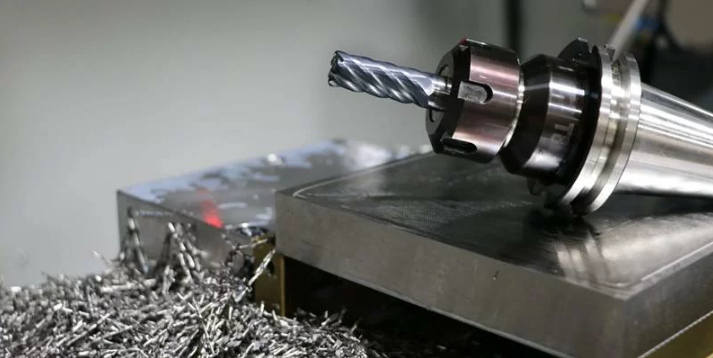カーバイド エンドミル。この小さくも力強い工具は、現代の製造業における縁の下の力持ちであり、驚くほどの精度とパワーで私たちを取り巻く世界を静かに形作っています。しかし、一体何が は 超硬エンドミルの特徴とは?
つまり、超硬エンドミルは、フライス盤で使用される切削工具で、材料を除去し、精密な形状やフィーチャを作成するために使用されます。超硬エンドミルの特徴は、その刃先にあります。 炭化タングステン超硬エンドミルは、非常に硬く、耐摩耗性に優れた材料です。つまり、超硬エンドミルは、高速度鋼 (HSS) 製のエンドミルに比べて、より過酷な被削材に対応し、高速加工が可能で、長寿命です。
しかし、その汎用性はそれだけにとどまりません。超硬エンドミルは、形状、サイズ、構成がめまぐるしく変化し、それぞれが特定の作業用に設計されています。そのため、幅広い産業や用途で欠かせない存在となっています。ここでは、最も重要な10種類の超硬エンドミルをご紹介します:

1.航空宇宙正確な飛行
航空宇宙産業では、最高レベルの精度と信頼性が要求され、超硬エンドミルが真価を発揮します。超硬エンドミルは、次のような用途に不可欠です:
- エンジン部品の加工 高温合金から複雑なタービンブレード、エンジンケーシング、その他の重要部品を製造。
- 構造部品の製造 機体、翼、胴体部分のような軽量かつ強靭な部品の成形と仕上げ。
- 内装部品の生産 座席、ギャレー、その他の備品のために、航空機の内装に正確な切り抜きやフィーチャーを作成する。
2.自動車製造業におけるイノベーションの推進
エンジンブロックからダッシュボードの複雑な部品まで、超硬エンドミルは自動車産業の形成に重要な役割を果たしています:
- エンジン製造: シリンダーヘッド、エンジンブロック、トランスミッションハウジングに精密な形状を作り出す。
- ボディとシャシーの構成部品: ボディパネル、ドアフレーム、シャーシ部品の複雑な形状や輪郭の加工。
- 金型製作 自動車の内装や外装に使われるプラスチックや金属部品を成形するための高精度な金型を製造。
3.メディカル:救命機器のエンジニアリング
医療業界では、超硬エンドミルは、複雑で、しばしば小型の部品を極めて高い精度で加工できることから、高い信頼を得ています:
- 手術器具: 鉗子、メス、ドリルなど、低侵襲手術用の繊細な器具の製作。
- インプラントと補綴: 人工股関節、膝関節、歯科用インプラントなど、カスタムフィットのインプラントを加工する。
- 医療機器: ペースメーカー、除細動器、画像診断装置など幅広い医療機器の部品を製造。
4.金型製作:製造業の未来を形作る
超硬エンドミルは、さまざまな製品の量産に使用される高精度の金型を作成するのに最適な工具です:
- プラスチック射出成形金型: 消費財や電子機器などのプラスチック部品を製造するための金型に、複雑なキャビティやフィーチャーを作る。
- ダイカスト金型: 複雑な形状や薄い壁を持つ金属部品を作るために使用される高温金型の機械加工。
- ブロー成形用金型: ボトル、容器、自動車部品など、中空のプラスチック製品を成形するための金型を製造。
5.エネルギー世界を精密に動かす
エネルギー分野では、発電や採掘に見られるような強靭な素材や過酷な条件下でも使用できる超硬エンドミルが頼りにされています:
- 石油・ガス探査 掘削装置、ダウンホールツール、パイプラインの部品加工。
- 発電: タービンブレード、バルブ部品、その他発電所の重要部品を製造。
- 再生可能エネルギー: 風力タービン、ソーラーパネル、その他の再生可能エネルギーシステム用部品を製造。
6.金型:製造業の基幹
超硬エンドミルは、無数の産業を形成する工具や金型の製造に不可欠です:
- 切削工具: スタンピング、フォーミング、シャーリング作業に使用されるパンチ、ダイ、その他の切削工具の製造。
- 成形用具: 曲げ加工、プレス加工、絞り加工により、金属やプラスチック部品を成形するための金型やダイスを製作する。
- 固定具と治具: 製造工程で使用されるワークホールディング治具や組立治具の精密部品を加工。
7.エレクトロニクスデジタル時代の実現
スマートフォンから回路基板まで、超硬エンドミルはエレクトロニクス産業で重要な役割を果たしています:
- 半導体製造: マイクロチップやその他の電子部品の製造に使用されるシリコンウェハー上に、高精度の形状を作り出す。
- プリント基板(PCB)製造: PCBに穴を開けたり、トレースを配線したり、その他の機能を作成する。
- 電子部品製造: 電子機器のコネクター、ハウジング、その他の部品を加工。
8.一般機械加工:多様なニーズに対応する汎用性
特殊産業だけでなく、超硬エンドミルは様々な分野の一般的な加工用途で活躍しています:
- プロトタイピング: 製品開発やテストのためのプロトタイプやワンオフパーツの作成。
- 修理とメンテナンス 交換部品の加工、損傷した部品の修理、一般的なメンテナンス作業。
- カスタム製作: 幅広い用途のカスタム部品やコンポーネントを製造。
9.ロボティクスオートメーションの未来を築く
ロボット工学とオートメーションが進歩し続ける中、超硬エンドミルは、これらのシステムを実現する精密部品の製造に不可欠です:
- ロボットアームとエンドエフェクター: ロボットアーム、グリッパー、その他アーム先端工具用の軽量かつ強靭な部品を加工。
- アクチュエーターとセンサー アクチュエーター、センサー、その他のロボット部品の精密なハウジングと取り付け機能を製造。
- オートメーション設備: 製造、物流、医療など様々な産業で使用される自動機械の部品を製造。
10.教育と研究イノベーションの未来を形作る
超硬エンドミルは、教育機関や研究施設では非常に貴重なツールです:
- 技術トレーニング: 機械加工、製造工程、材料科学の実地体験を学生に提供。
- 研究開発: 研究者がカスタム実験セットアップ、テストフィクスチャー、プロトタイプコンポーネントを作成できるようにする。
- 材料科学: 様々な加工条件下での材料の特性と挙動を研究する。
仕事に適した道具を選ぶ
超硬エンドミルは、非常に多くの種類があるため、適切なものを選ぶのは大変です。簡単なガイドをご覧ください:
| 特徴 | 考察 |
|---|---|
| フルート数 | 粗加工用にはより少ないフルート(より速い材料除去)、仕上げ用にはより多くのフルート(より滑らかな表面) |
| フルートの形状 | 溝加工用ストレートフルート、汎用ヘリカルフルート、振動低減用可変ヘリックス |
| エンドミル径 | 希望のスロット幅または穴サイズに合わせる |
| コーティング | 汎用TiN、高硬度TiCN、高温用AlTiN |
業界や用途を問わず、超硬エンドミルは精密加工に不可欠な工具としてその地位を確立しています。強靭な被削材に対応し、卓越した精度を実現し、工具寿命を延ばすことができる超硬エンドミルは、私たちを取り巻く世界の形成に欠かせないものとなっています。
もっと知りたいですか?どうぞ クリック.




